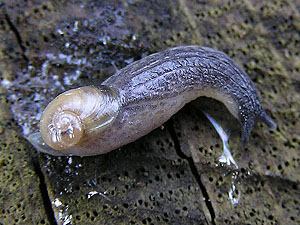
Reddish Daudebardia (Daudebardia rufa), a predator, which
usually feeds on earthworms. Source: biolib.cz (Jiří Novák).
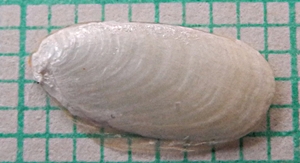
Shell rest of Limax maximus. Picture: Jonathan Neumann.
 Reddish Daudebardia (Daudebardia rufa), a predator, which usually feeds on earthworms. Source: biolib.cz (Jiří Novák). |
|
 Shell rest of Limax maximus. Picture: Jonathan Neumann. |
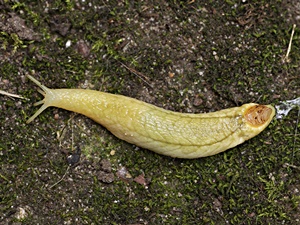 Yellow-grey shelled slug (Testacella haliotidea). Picture: M. Gurney (Flickr.com). |
The domestic glass snails (Vitrinidae) are not the only snail group, among which shell reduction, accordingly called vitrinisation, can be observed. Especially for predatory terrestrial snail groups, a reduction of the shell means decisive advantages. So for example the genera in the subfamily Daudebardiinae (Family Oxychilidae) can hunt for earthworms in the earth, which would be rather hard carrying a complete shell.
family which is distributed in western Europe also hunts for earthworms underground, and those snails as well only have a small shell rest left on their rear back, which they cannot retreat into. However, both are not more closely related. While Daudebardiinae are related to glossy snails (Oxychilidae), the Testacellid family is more closely related to the Oleacinidae, a family of mostly neotropic distribution with members such as the rosy wolf snail (Euglandina rosea) and the dalmatian predator snail (Poiretia cornea).
Snails like Daudebardia and Testacella with only a small shell rest left and unable to withdraw into it, are called semi-slugs.
![]() Francisco Welter Schultes:
Daudebardia rufa species homepage.
Francisco Welter Schultes:
Daudebardia rufa species homepage.
![]() Francisco Welter Schultes:
Testacella haliotidea species homepage.
Francisco Welter Schultes:
Testacella haliotidea species homepage.
The different degrees of shell reduction can well be observed within the three slug families of round back slugs (Arionidae), keel back slugs (Limacidae) and Milacidae, a smaller slug group that is even more keeled than the keel back slugs. While limacids and milacids still have a small internal shell rest left, arionids have nothing like that left, after the dissolution of the snail only a few calcium carbonate grains remain. This situation is comparable to octopuses (Octopodidae), squids (Loliginidae) and cuttlefish (Sepiidae) among cephalopods.
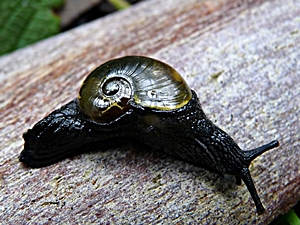 Helicarion nigra (Australia). Picture: Lorraine Phelan (Source). |
|
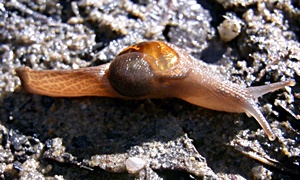 Helicarion mastersi (Australia). Picture: Peter Woodard (Source). |
|
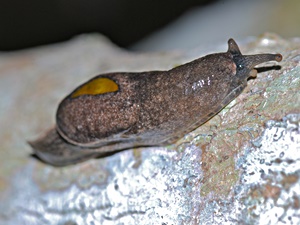 Parmarion martensi (Malaysia). Picture: Bernard Dupont (Source). |
But there is also a shell reduction going on in other snail groups, though not especially in connection with predatory behaviour. This however makes it evident that slugs have developed not once among terrestrial gastropods, but rather numerous times and independently.
The Helicarionidae family for example is distributed in the eastern Palearctic (see Faunal Provinces of Earth), Malagasy (Madagascar, India, Southeast Asia and Australia. The scientific name of the family already describes the special character of this family: Those snails look like a mixture between a snail (Helix)and a slug (Arion). However, the Helicarionidae are rather more closely related to keel back slugs (Limacidae) than round back slugs (Arionidae).
The species of the name-giving genus Helicarion present in Australia display a shell reduction similar to the European glass snails (Vitrinidae). While Helicarion nigra has a nearly complete shell, in Helicarion mastersi it is already partly covered by the mantle. Like in many European Vitrinidae, in Helicarion mastersi the mantle extends a broad flap to cover parts of the shell. What is also remarkable is, that Helicarionidae snails produce a love dart, but theirs is made from chitin, not from calcium carbonate like, for example, in relatives of the Roman snail (Helicidae).
From Tasmania, in 2017, a new species, Attenborougharion, has been newly described, which apart from a very colourful appearance also displays a rather advanced stage of vitrinisation.
|
|
Helicarionidae: On wikipedia.org. |
|
|
Hyman, I., Köhler, F. (2017): Attenborougharion gen. nov.(Mollusca: Pulmonata: Helicarionidae): A likely case of convergent evolution in southeastern Tasmania. Rec. Aust. Mus. 69/2, pp. 65–72. |
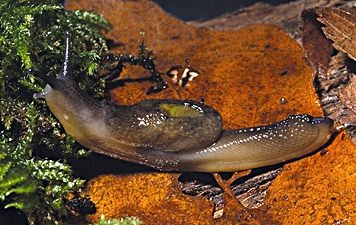 Dromedary jumping slug, Hemphillia dromedarius). Picture: Kristiina Ovaska (Source). |
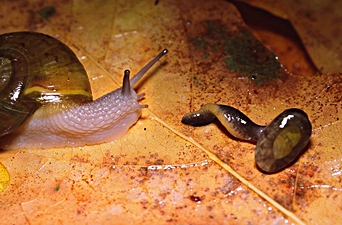 Robust lancetooth (Haplotrema vancouverense, left) and Dromedary jumping slug (Hemphillia dromedarius, right). Picture: Kristiina Ovaska (Source). |
The unrelated yellow-shelled semi-slug (Parmarion martensi) from the Ariophantidae family has a similar appearance. Most likely coming from Southeast Asia, this species has been introduced to the Western United States and became an agrarian pest in Hawaii, for example. Also, it can be contagious with a nematode, the rat worm (Angiostrongylus cantonensis).
|
|
Hollingsworth et al. (2007): "Distribution of Parmarion cf. martensi (Pulmonata: Helicarionidae), a New Semi-Slug Pest on Hawai‘i Island, and Its Potential as a Vector for Human Angiostrongyliasis". Pac. Sci. 61(4): 457-467. |
|
|
Cowie, R. H., Dillon R. T., Robinson, D. G., Smith, J. W. (2009): "Alien non-marine snails and slugs of priority quarantine importance in the United States: A preliminary risk assessment". Amer. Malac. Bull. 27: 113-132. |
Last, but not least, there are quite a number of slugs, which do not look like European slugs. While in those the mantle only covers a part of the foot, looking like a shield (the mantle shield), there are also others. So for example in the North American slug species Megapallifera mutabilis (Familie Philomycidae), the mantle covers all of the slug's back (which is why the species is called Megapallifera, meaning "bearer of a large mantle"). Slugs from the Veronicellidae family for example look like a giant mantle crawling around, only the tentacles sometimes looking out from under it. This is why those slugs are also called leatherleaf slugs.
|
|
Megapallifera mutabilis aus Massachusetts, USA: Picture by Paul J. Morris on Flickr.com. |
|
|
Veronicellidae: Caribbean Leatherleaf (Sarasinula plebeia) on Jaxshells.org. |